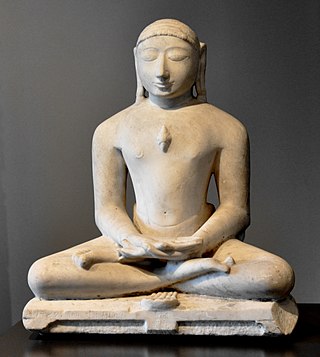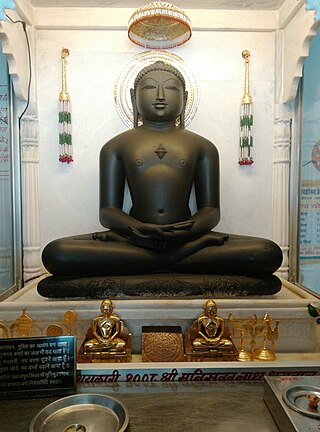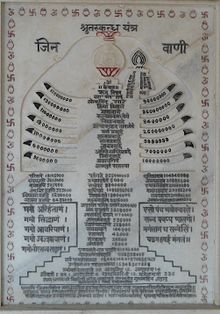Jainism, also known as Jain Dharma, is an Indian religion. Jainism traces its spiritual ideas and history through the succession of twenty-four tirthankaras, with the first in the current time cycle being Rishabhadeva, whom the tradition holds to have lived millions of years ago, the twenty-third tirthankara Parshvanatha, whom historians date to the 9th century BCE, and the twenty-fourth tirthankara Mahavira, around 600 BCE. Jainism is considered to be an eternal dharma with the tirthankaras guiding every time cycle of the cosmology. The three main pillars of Jainism are ahiṃsā (non-violence), anekāntavāda (non-absolutism), and aparigraha (asceticism).

Sutra in Indian literary traditions refers to an aphorism or a collection of aphorisms in the form of a manual or, more broadly, a condensed manual or text. Sutras are a genre of ancient and medieval Indian texts found in Hinduism, Buddhism and Jainism.

Mahavira also known as Vardhaman, Mahavirswami, was the 24th tirthankara of Jainism. He was the spiritual successor of the 23rd tirthankara Parshvanatha. Mahavira was born in the early part of the 6th century BCE into a royal Kshatriya Jain family in ancient India. His mother's name was Trishala and his father's name was Siddhartha. They were lay devotees of Parshvanatha. Mahavira abandoned all worldly possessions at the age of about 30 and left home in pursuit of spiritual awakening, becoming an ascetic. Mahavira practiced intense meditation and severe austerities for twelve and a half years, after which he attained Kevala Jnana (omniscience). He preached for 30 years and attained Moksha (liberation) in the 6th century BCE, although the year varies by sect.
Acharya Aryanandi was a prominent Jain monk of the early 20th century. He is best known for his work in establishing several Jain schools in the Indian state of Maharashtra. Several Jain monks before him have also been named Aryanandi.

In Jainism, a Tirthankara is a saviour and spiritual teacher of the dharma. The word tirthankara signifies the founder of a tirtha, which is a fordable passage across the sea of interminable births and deaths, the saṃsāra. According to Jains, Tirthankars are the supreme preachers of Dharma, who have conquered the saṃsāra, the cycle of death and rebirth, on their own, and made a path for others to follow. After understanding the true nature of the self or soul, the Tīrthaṅkara attains Kevala Gyana (omniscience). Tirthankara provides a bridge for others to follow the new teacher from saṃsāra to moksha (liberation).
In Jainism, godliness is said to be the inherent quality of every soul. This quality, however, is subdued by the soul's association with karmic matter. All souls who have achieved the natural state of infinite bliss, infinite knowledge, infinite power and infinite perception are regarded as God in Jainism. Jainism rejects the idea of a creator deity responsible for the manifestation, creation, or maintenance of this universe but rather have souls called devas and devis who have reached heaven for their merits and deeds, who influence the universe for a fixed time until they themselves get reincarnated to achieve and continue the cycle of enlightenment. According to Jain doctrine, the universe and its constituents have always existed. All the constituents and actions are governed by universal natural laws and perfect soul, an immaterial entity cannot create or affect a material entity like the universe.
Jain rituals play an everyday part in Jainism. Rituals take place daily or more often. Rituals include obligations followed by Jains and various forms of idol worship.

Suparshvanatha, also known as Suparśva, was the seventh Jain Tīrthankara of the present age (avasarpini). He was born to King Pratistha and Queen Prithvi at Varanasi on 12 Jestha Shukla in the Ikshvaku clan. He is said to have attained moksha at Shikharji on the sixth day of the dark half of the month of Phālguna.

Śhāntinātha or Śhānti is the sixteenth Tīrthaṅkara of Jainism in the present age. According to traditional accounts, he was born to King Vishvasena and Queen Aćira of the Ikshvaku dynasty in the north Indian city of Hastinapur. His birth date is the thirteenth day of the Jyest Krishna month of the Indian calendar. He was also a Chakravartin and a Kamadeva. He ascended to the throne when he was 25 years old. After over 25,000 years on the throne, he became a Jain monk and started his penance.

Munisuvrata was the twentieth tirthankara of the present half time cycle (avasarpini) in Jain cosmology. He became a siddha, a liberated soul which has destroyed all of his karma. Events of the Jaina version of Ramayana are placed at the time of Munisuvrata. Munisuvrata lived for over 30,000 years. His chief apostle (gaṇadhara) was sage Malli Svāmi.

The Pañca-Parameṣṭhi in Jainism are a fivefold hierarchy of religious authorities worthy of veneration.
Kevala gyana or Keval gyan means omniscience in Jainism and is roughly translated as complete understanding or supreme wisdom.
Jainism emphasises that ratnatraya — the right faith, right knowledge and right conduct — constitutes the path to liberation. These are known as the triple gems of Jainism and hence also known as Ratnatraya
Jain literature refers to the literature of the Jain religion. It is a vast and ancient literary tradition, which was initially transmitted orally. The oldest surviving material is contained in the canonical Jain Agamas, which are written in Ardhamagadhi, a Prakrit language. Various commentaries were written on these canonical texts by later Jain monks. Later works were also written in other languages, like Sanskrit and Maharashtri Prakrit.

Arihant is a jiva (soul) who has conquered inner passions such as attachment, anger, pride and greed. Having destroyed four inimical karmas, they realize pure self. Arihants are also called kevalins as they possess kevala jnana. An arihant is also called a jina ("victor"). At the end of their life, arihants destroy remaining karmas and attain moksha (liberation) and become siddhas. Arihantas have a body while siddhas are bodiless pure spirit. The Ṇamōkāra mantra, the fundamental prayer dedicated to Pañca-Parameṣṭhi, begins with Ṇamō arihantāṇaṁ, "obeisance to the arihants".

Vishwa Jain Sangathan (VJS) is a religious and social service organization of Jains in India. Amongst other things, it was involved in the Jain minority campaign.

Chandraprabha or Chandranatha is the eighth Tirthankara of Tīrthaṅkara of Jainism in the present age. According to traditional accounts, he was born to King Mahasena and Queen Lakshmana Devi at Chandrapuri to the Ikshvaku dynasty. According to Jain texts, his birth-date was the twelfth day of the Posh Krishna month of the Indian calendar. He is said to have become a siddha, a liberated soul which has destroyed all of its karma.
The history of Jainism in Australia is relatively short when compared to the history of Christianity on the same continent. There are four Jain centres in Australia. The Jain population in Australia was counted in the 2016 census to be 4,047, of whom 38% lived in Greater Sydney, 31% in Greater Melbourne, and 15% in Greater Perth. The states and territories with the highest proportion of Jains are Western Australia (0.025%) and Victoria (0.022%), whereas those with the lowest are Queensland (0.006%) and Tasmania (0.001%).
The Akram Vignan movement, also spelled Akram Vijnan, is a new religious movement originated in 1960s in Gujarat, India. It was founded by Dada Bhagwan and later spread to Maharashtra and Gujarati diaspora communities around the world. After death of Dada Bhagwan, the movement split in two factions: one led by Niruben Amin and the other led by Kanubhai Patel.












